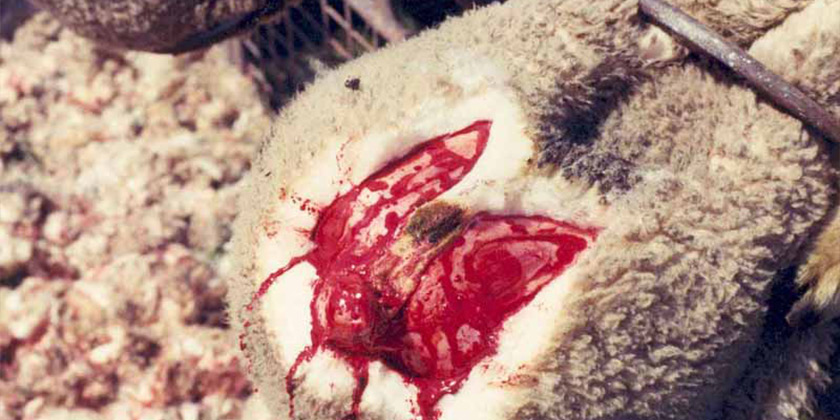Despite their gentle nature and capacity to suffer as any other animal, sheep aren’t protected by the same laws as dogs and cats. ‘Codes of Practice’ side-step the rules, allowing farmers to cut bits and pieces off young lambs without even providing them pain relief.
This image contains content which some may find confronting

Tail docking
Like puppies, lambs are born with a long tail. But most lambs are put in a restraint device and have their tail cut off (like tail docking: to reduce soiling and the risk of flystrike). When lambs are less than 6 months old, this practice can be done without anything to dull the pain. Often (as in the video below) lambs are also mulesed at the same time.
A hot blade or sharp knife is used to cut through the muscle and bone of the lamb’s tail. On some farms, lambs will instead have a rubber ring tightened around their tail so that it will wither and drop off.
If a lamb’s tail is cut too short, they are at higher risk of suffering from serious health complications, such as rectal prolapse.
Mulesing
Young lambs often have the skin around their buttocks and the base of their tail cut off with a pair of metal shears (to reduce soiling and the risk of flystrike). This painful practice, called mulesing, has been banned in New Zealand for cruelty, but sadly is still legal in Australia, and in most states can be performed without any pain relief. Thanks to tireless animal advocates speaking out, Victoria recently became the first and only state to require at least some pain relief for the procedure. Tasmania will soon follow suit, and become the second state to introduce some pain relief for mulesing of sheep, from July 2024.
The large, open wound created by mulesing can take many weeks to heal. During this time, lambs are at added risk of infection and flystrike.
This image contains content which some may find confronting

While mulesing is inflicted on lambs to reduce flystrike, several other less invasive and much less painful solutions exist. In 2010, the leaders of the Australian wool industry backed down on a commitment to phase out mulesing in favour of more humane alternatives. In 2016, wool industry leaders would not even support mandatory use of pain relief for mulesed lambs (let alone start a phase-out of mulesing), so sadly millions of lambs in Australia are continuing to undergo this cruel surgery, many with no pain relief whatsoever.
Castration
Male lambs usually have to endure both castration and tail docking (and sometimes mulesing) at the same time. When these procedures are carried out by unskilled people, the risk of greater injury, and infection is even more significant.
MISSING IMAGE GALLERY HERE
Shearing
Shearing is not only stressful for sheep who are inherently fearful of human handling but rough treatment in the shearing shed also puts them at risk of injury. Sheep are often cut by the sharp shearing blades, and when they suffer larger wounds, it is considered acceptable industry practice to stitch them up without providing any pain relief. As with those who carry out other painful, invasive procedures, there is currently no requirement for shearers to undergo formal training and accreditation.
Invasive breeding procedures
Female sheep are also often forced to endure invasive procedures. In one common breeding procedure, called laparoscopic artificial insemination, a long metal rod is poked through the ewe’s abdomen to insert semen into her uterus. This invasive procedure can be done without pain relief.
You can help!
Tell the Australian wool industry, “Surgery hurts!” and demand mandatory pain relief for sheep and lambs.
Call for live sheep exports to end as soon as possible: The grim fate for many sheep in Australia is to be loaded onto ships in the live export trade. Exported to countries with no laws to protect them, these animals can suffer unspeakable abuses — including having their throats cut whilst fully conscious. Click here to urge decision-makers to legislate the date for the phase-out of live sheep exports as soon as possible.
Make your choices count: Caught in a profit driven industry, sheep are forced to endure these painful procedures because of demand for lamb, mutton and wool. But fortunately, the choices we make at the dinner table (and when buying clothes) can spare them. By making the choice to eat more meat-free meals, or take animals off your plate completely, you can help protect sheep and save lives. Check out our guide to compassionate living to find out more about how your everyday choices can help shape a kinder world for sheep.












